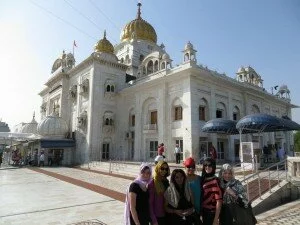It has happened again. Within just a few short weeks we have witnessed two shootings where innocents have died at the hands of a gunman whose reasons escape all logic. We may never be able to understand why someone would walk into a theatre and open fire on movie goers, and we may not know how to prevent it. But when someone walks into a temple and opens fire, the reason behind it is clear. A lack of understanding caused someone to make a false assumption, and because of their personal beliefs they took lives of people worshipping their god. We can’t change what happened in Oak Creek, Wisconsin this evening, but we can prevent it. By educating ourselves and others about what Sikh’s believe and who they are, we can stop the next person from committing a hate crime.
In the CCMBA 2012 program we have 3 Sikh’s who have each made strides to do just that. Ravi Bansal, Raj Jhawar, and Rekha Raju have been wonderful ambassadors of their faith. So rather than only educate our small population of 150 students, here’s my attempt at reaching a larger audience.

Taken by Sonal Patel
When we went to New Delhi, India for Term 4, only a few blocks away from our hotel there was a Sikh temple just like the one in Wisconsin. It was early one morning before classes when 2/3s of the CCMBA Sikh population guided a handful of us to see what the religion was all about. As I walked in wearing jeans and flip flops, the thought crossed my mind that perhaps tourists may not be welcome.
That could not have been further from the truth. Eventually an older gentleman, yes, wearing a turban, walked up and welcomed us. He explained how to check our shoes in, the procedures for washing our hands and feet so we could enter the temple clean, and even provided those of us who needed it with bandannas to cover our hair.
This turbaned gentleman then took us up a staircase where the sounds of scripture being read grew louder and louder. We entered into the sanctuary, which was largely an open floor with an area in the middle where the priest read scripture aloud into a microphone. The Sikh’s worshiping there sat quietly in contemplation and barely moved as they absorbed what was being read.

Photo Taken by Sonal Patel
As tourists we made a loop around the room, and came to a small area at the back of the building where gatherers were congregated. Inside a small room with an elaborate door, the sacred scriptures were housed. We all sat for a few minutes in silence before we exited the temple.
When we exited the temple we were greeted by the same man, this time handing us a special sweet that he insisted we try because it was eaten after the service. While we were wary of how our Western digestive systems would handle this delicacy, we each carefully pinched off a piece and I must admit the honey flavored treat was something I’d try again.
It was at this point that our group was taken to a magnificent oasis in the middle of busy New Delhi. Hidden on the back side of the temple was an amazing wading pool, filled with clean flowing water. With the New Delhi sun already beating down on us so early in the morning, the water looked inviting.
Our tour wasn’t done there. We were taken to a kitchen, where volunteers from the Sikh temple manned a full service kitchen that was open 24 hours a day. They served the poor, the rich, and Western tourists.
As we collected our things we were all grateful to have a small insight into what had always been a foreign religion. Suddenly the mystery and “strangeness” melted away, and there was an understanding, that Sikhism is similar to so many religions we in the West already know.

Debbie Barabe, Ravi Bansal, Neeharika Sinha, Sonal Patel, Jordan Lofton, Kristin Swartz
Now that you have read my description of the Sikh temple in New Delhi, think about the description of what you have heard on the news about the shooting in Wisconsin. Imagine someone walking in to an open room with people sitting on the floor in prayer and opening fire. Imagine the gatherers in front of the Holy Scriptures being cornered by a gunman. Imagine the normal noises of a soup kitchen being interrupted by gunfire and screams. Now imagine, that without saying a word or moving a muscle you could take the gun from this person’s hands and end the violence.
By reading about what your classmate Ravi Bansal has shared below about Sikhism and educating the people you know, you can do just that.
What is your religion or faith?
In all honesty I believe in Ravi-ism. By that I mean that I believe in a god but I am not tied to just one religion. I was born into a household that practiced both Hinduism and Sikhism.
Were you born into this faith or did you choose to convert to this faith? If you were born into the faith, describe how your faith was developed as a child. If you chose to convert to this faith describe what drew you to this faith.
I was obviously born into both practices. It was interesting because when I was a child I actually tried to run away from religion and religious studies. We have “Sunday school” and I really didn’t want to have anything to do with it then because I wanted to do what my friends were doing.
As I got older I really wanted to learn more about everything. I was very curious about Hinduism and I wanted to know more about it. I studied Sikhism and wanted to learn more. So now I think I have a great passion to learn about those religions in particular, but other religions as well.
What is/are the core belief(s) of this faith?
Hinduism-
With Hinduism you have to think of Hinduism as a continent. There are really many different religions within one. There were several kingdoms with their own version of what we call Hinduism today. King Asoka tried to take over the various kingdoms and with his conquering the many religions became blended and labeled as one religion, Hinduism. In reality there are many different ways to practice, for instance some Hindus are strict vegetarians and would never touch meat, whereas others practice animal sacrifice monthly.
In my sect, we believe there is one god and he/she takes many different forms. All the forms that you see of god are really just a expressions of god. It’s not many different gods that live in heaven together as one big family, but rather each form is just one aspect of the one god.
Sikhism-
In Hiduism you have Namaste which is Nama sate means “God is true.” In Sikhism the greeting is Sat Sri Akal which means “God is true.” So you can see that there are similarities between the two.
The founder of Sikhism is Guru Nanak Dev Ji who believed that we’re all equal and that we’re all equal in God’s eyes. There are 10 gurus which are similar to prophets. Sikh actual means student for life. We have something called Ek Om Kar which means “There is only one god.” In Sikhism there are 5 K’s and they define a Sikh and was developed by the last guru during a time of fighting between the Hindus and Muslims at a time when people were being forcibly converted to Islam. A Sikh was a protector and would stand up for any unjust. Guru Govind Singh Ji gave Sikhism their identity with the 5 K’s that represent a warrior because it came out of time of war.
- Kase – long hair- in a time of war you do not have time to cut your hair. This is the reason Sikhs wear turbans.
- Konga – the comb- the warriors would comb their hair and keep clean to protect from spreading disease amongst their troops.
- Karpan – the sword- used for protection
- Kachera – warrior shorts- because it’s hot warriors did not wear armor but wore light clothing that resembled shorts so they could move quickly and stay cool.
- Kara – metal bracelet- originally this was a large metal cuff worn around the wrists that was used as a shield to block attackers. Today, this is now worn as a bracelet and identifies a Sikh and a reminder that as a Sikh you are a protector. Because it is circular it represents that life is never ending.
Do you believe in a god(s)?
In India there is a saying: “Ishwar allah tero nam saab ko sumpaty deh baghwaan.”
Translation: Some call you Ishwar(God) Some call you Allah (God) give peace to all baghwaan (God)
Basically in Hinduism and Sikhism there are several names for God but the true believe is there is only one god. It is actually a sin to put down anyone “else’s” religious reference to god because technically you are putting down the same god you believe in.
Another similarity between Hinduism and Sikhism is in both religions every nationality and everyone is accepted into the Mandier (Hindu temple) and Gurdwara (Sikh Temple). Everyone is served parshaad (food which is a blessing from god) and all are expected to sit equally when being served food.
A difference I would point out between the Hinduism and Sikhism is that in Hinduism we believe that there are incarnations of god. In Sikhism that is not a belief.
Do you have a concept of “salvation”? If so, how is that obtained?
In both religions we believe in Karma (do good and you shall receive good), we also have the concept of reincarnation. The ultimate goal is not to be reincarnated and go back to the light (god) but your new birth’s life circumstances depend on your deeds from your past life.
As a child I always used to ask my grandma why I was so lucky to be born in a country like Canada and have a wonderful family, while other kids around the world suffered. My grandma explained this with the concept of Karma, and also reminded me that the reason why god gave me these strengths and benefits is to use them to help others in need. In Sikhism and Hinduism God loves all his/her children and we believe in charity to give back and help others in need. That is an integral part of our salvation.
What are some ways that believers of your faith practice on a daily basis?
Both my mom and dad practice prayers every morning and evening.
Fasting is a very common practice in Hinduism but not so much in Sikhism.
Sunday is generally a big prayer day and day for worship.
Another similarity between the two religions is there is no conversion process. You can become baptized but baptism is very strict in both religions. But anyone can go to a Sikh or Hindu temple freely, be married in a Sikh or Hindu ceremony and be part of the congregation without any baptism. If you want to be Hindu or Sikh just say it.
What is/are some common mis-conception(s) about your faith? Can you share an explanation to clarify this misconception?
I think the number one misconception is that Hinduism polytheistic. It is labeled as polytheistic but there are many Hindus that don’t see it that way. They really do believe in just one god.
I think for both there is a perception of an inequality of women in the religion. In reality that inequality is in the culture itself. Hinduism has female versions of god, and Sikhism treats everyone as equal, so it is not a belief that women are lesser in the religion, but how people practicing that religion are behaving that causes the misconception.
Is there a verse or passage you’d like to pass along to the CCMBA class as encouragement for completing our degree?
Hinduism-
“On this path effort never goes to waste, and there is no failure. Even a little effort toward spiritual awareness will protect you from the greatest fear.” Gita
Sikhism-
“As she has planted, so does she harvest; such is the field of karma.” Sri Guru Granth Sahib quote.
“While you are alive, conquer death, and you shall have no regrets in the end.” Sri Guru Granth Sahib quote.




